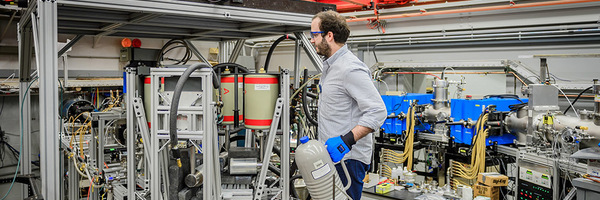
Research
The research focus at ISNAP is on three aspects of low energy nuclear physics, nuclear astrophysics, nuclear structure physics and nuclear physics applications with societal impact.
The experimental program is primarily focused on the utilization of the accelerator facilities of the Notre Dame Nuclear Science Laboratory (NSL). The 5MV single-ended Pelletron is primarily used for low energy nuclear astrophysics experiments with light and heavy ion beams. The 10 MV FN tandem accelerator serves a program in Accelerator Mass Spectrometry (AMS), and is used for a broad variety of nuclear reaction and scattering studies. The tandem is also the driver for the TriSOL radioactive beam facility, which enjoys a large user community. A 3MV tandem Pelletron accelerator is serves a program in nuclear science applications, primarily PIGE/PIXE and radiation chemistry. ISNAP plays a key role in the development of new facilities for nuclear physics; presently ISNAP spearheads the development of the CASPAR underground accelerator facility at the Sanford Underground Research Facility (SURF) at Homestake Mine in South Dakota, but also plays a key role in the development of the SECAR recoil separator for nuclear astrophysics research at FRIB.
The theoretical program at ISNAP is motivated by the needs of the experimental program. It has been instrumental in the development of new phenomenological methods for interpreting nuclear reaction mechanisms and for identifying key nuclear parameters that need to be studied. The multi-channel, multi-level R-matrix code AZURE today serves a broad community of users. The statistical model codes CIGAR and SAPPHIRE also play an increasingly important role in the community. R-process simulations have been instrumental to prioritize studies of nuclei near or at the R-process path for radioactive beam facilities world-wide. In addition, the ISNAP researchers work in close collaboration with the University nuclear theory group.
Nuclear astrophysics aims at the understanding of low energy nuclear reaction and decay processes in quiescent and explosive stellar burning processes. It defines the conditions and timescales for these processes, identifies their role and contribution in the origin of the chemical elements, and identifies characteristic features or signatures in astrophysical observables. ISNAP operates a broad nuclear astrophysics program using both stable and radioactive beam techniques. It is primarily focused at the use of local facilities but maintains also a strong experimental program at the LUNA underground facility at Gran Sasso, Italy while implementing the CASPAR underground accelerator at the Sanford Underground Research Facility in South Dakota. The local program is also complemented by reaction and decay studies using the CARIBU facility at Argonne National Laboratory, ReA-3 at the NSCL at Michigan State University, and the cyclotron laboratories at RCNP in Osaka, Japan and i-Themba in Stellenbosch, South Africa.
Nuclear structure physics is concerned with the emergence of collectivity in the evolution of structure from closed shells and single particle states to mid-shells and beyond in nuclei. A central focus of ISNAP research interest is in the study of exotic or neutron rich nuclei far from stability and the role that nuclear structure plays in various astrophysical scenarios. The onset of deformation and its impact on various nucleosynthesis scenarios such as the r-process, rp-process, and the p-process is of particular interest. The role of clusters in light nuclei is another focus in both nuclear structure and the impact of this phenomenon in the study of complex stellar burning mechanisms in nuclear astrophysics. Also, the study of giant resonances features as signature for nuclear incompressibility.
Nuclear applications are an emerging area and complement the fundamental research activities of ISNAP. AMS is used for identifying smallest amount of products of critical reactions in supernova explosions, but also for identifying long-lived radioactive depositions from stellar explosions in lunar, meteoritic, and deep-ocean samples. Proton Induced X-ray Emission (PIXE), X-Ray Fluorescence (XRF), and Raman spectroscopy tools are used for studies of novel materials for nuclear experiments as well as materials of human heritage.
Fundamental Symmetries aims at answering whether the fundamental interactions that are basic to the structure of matter are fully understood. Precision measurement of nuclear beta decay is one of the probes used to test the Standard Model of the electroweak interaction. An ongoing program of precision lifetime measurements at ISNAP aims at improving the precision and accuracy of half-lives of superallowed mirror transitions. These transitions can form a second (the other being the superallowed pure Fermi transitions) data set from which the charge vector current (CVC) hypothesis can be tested and the Vud matrix element of the Cabibbo-Kobayashi-Maskawa (CKM) matrix extracted. However, to test the CVC hypothesis, one needs to measure the Fermi-Gamow-Teller mixing ratio. To do so, an ion trap is currently being developed. This local program is complemented with high-precision Q-values measurements of superallowed pure Fermi and mirror transitions at the NSCL and beta-neutrino correlation measurements at Argonne National Laboratory.
User activities at ISNAP facilities include a broad portfolio of nuclear reaction studies with stable and radioactive beams, as well as detector development studies for the nuclear physics and high energy physics community. Although the NSL is not funded as user facility, researchers from more than 30 countries often collaborate with us on experiments using our accelerators.